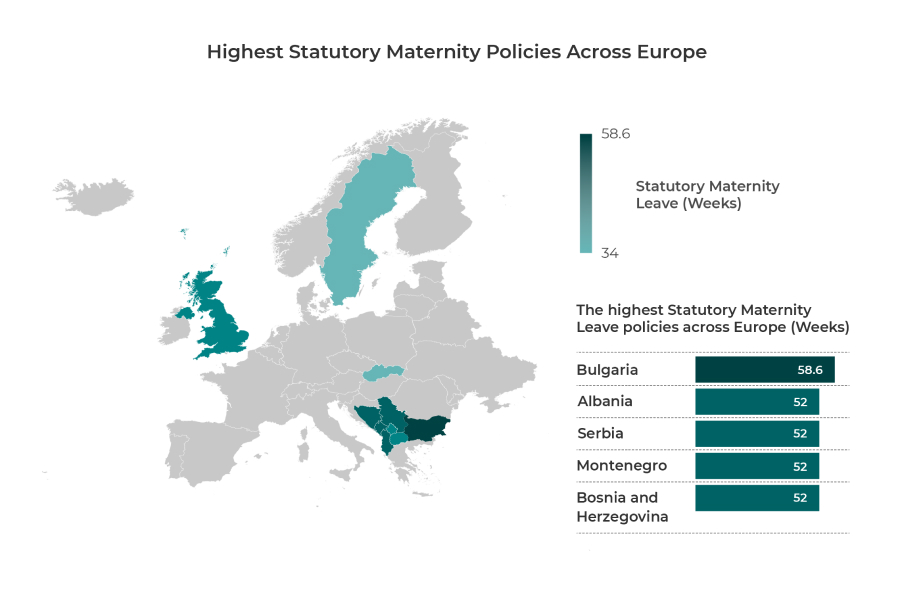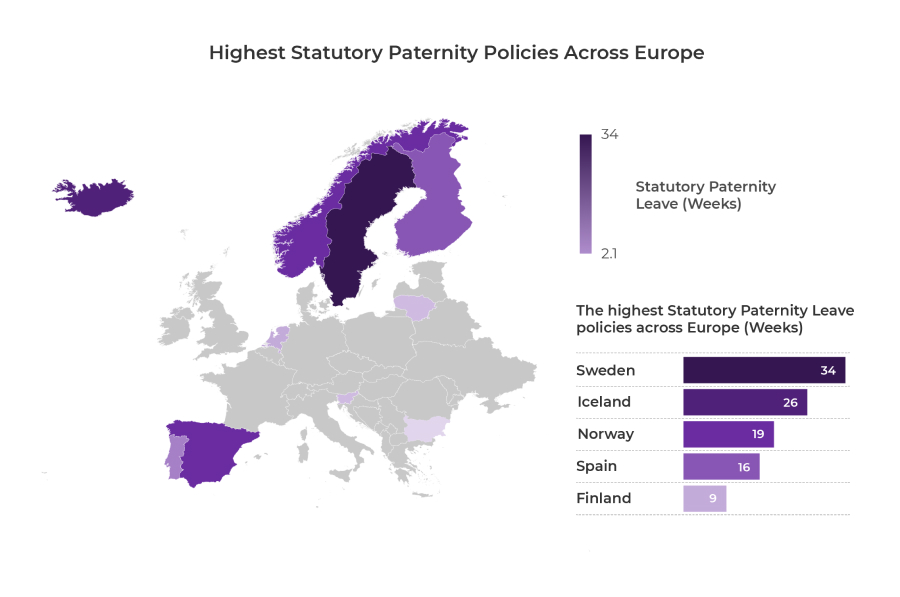Talent management
Shared parental leave is on the rise: Here’s how to make it work for you and your team

In the last few years, ‘shared parental leave’ has become a progressively more popular area of interest for UK workers. Shared parental leave is where both parents can take time off in a more flexible way during your baby’s first year.
We spoke to Pablo Vandenabeele – Clinical Director for Mental Health at Bupa UK– who shared his advice on making parental leave work for you – whether you’re a parent or an employer.
Maternity and paternity leave across Europe
We analysed every country in Europe to find out who offers the most statutory maternity and paternity leave for new parents. This means the number of days new mums and dads can take off work whilst still being paid from their employer when a child is born.
- Currently Bulgaria offer the highest paid time away from work (statutory maternity leave) for new mums at 58.6 weeks.
- Norway, Serbia, Albania and Bosnia and Herzegovina all offer 52 weeks of statutory maternity leave.
- 1In the UK women are entitled up to 52 weeks maternity leave, but only up to 39 of these must be paid by your employer.

Across most countries in Europe fathers are entitled to fewer days off work during their baby’s first year compared to mothers (known as statutory paternity leave). The average paid paternity leave across Europe is 3.3 weeks.
- Overall, Nordic countries (Sweden, Norway, Finland and Iceland) offer generous paternity leave policies.
- Sweden offers the highest statutory paternity leave at 52 weeks.

Similarly, Nordic countries are paving the path for more flexible parental leave policies for both mothers and fathers. For example, parents in Sweden are entitled to 68.5 weeks parental leave after a child is born. 90 days of this leave is exclusively allocated to each parent, but how the remainder of the leave is split can be decided by the parents.
2Iceland, 3Norway, 4Finland, and Denmark5 also follow similar shared parental leave policies allowing the parents to share leave after a child is born equally – this type of leave is known as shared parental leave.
Shared parental leave
6Shared parental leave (SPL) is a flexible childcare option that allows new parents to share their leave between them, potentially splitting leave equally. Shared parental leave offers greater opportunities for partners to stay at home with their child for longer.
How much shared parental leave new parents are allowed is different for each country. But in the UK7 new parents can take up to 50 weeks of shared parental leave. With up to 37 weeks of shared parental pay – meaning new parents opting for shared parental leave are entitled to 37 weeks’ pay from their employer. Those who are adopting a child or have a child through surrogacy are also eligible for SPL.
Here’s how to support your team with shared parental leave as an employer:
Shared parental leave is becoming increasingly popular with new parents, with a 33% increase in Google searches for ‘shared parental leave’ in the UK over the past year.
8In the UK parents can take SPL in many ways, for example,
- the birth parent or primary adopter can return to work early from maternity or adoption leave and then takes SPL at a later date
- the birth parent or primary adopter returns to work and their partner takes SPL
- both parents are off at the same time
- both parents share SPL evenly, taking their time off at different times
We spoke to Pablo Vandenabeele, Clinical Director for Mental Health, who said, “as an employer, informing your team of all the childcare options available to them will help your employees to be able to make decisions that work best for them and their families.
It can be a stressful time for both parents, so it’s important to support them in every way possible. Make sure your workplace is both transparent and clear about what exactly is on offer, as well as any additional support available for new parents.
9Similarly, allowing parents more choice and flexibility to combine work with childcare responsibilities means that as an employer, you’ll be able to better recruit and retain talent.”
Creating more options for new parents gives them greater choice in how to balance their own work and home life. Here’s how to support your employees through shared parental leave:
10Inform your employees of all their options
For those parents considering SPL it’s important to provide them with clear and accurate information about what your business offers. This will help them decide which option works best for themselves, partner and families.
If you’re unable to advise your team members on SPL or other childcare options put them in touch with a department within your workplace that can.
Similarly, if you don’t have a dedicated department that can advise your employees on SPL, there are lots of organisations that can help – such as; acas, Maternity Action and the Gov.UK
Work with your employees
As a new parent, it can be daunting – and a little confusing – to try and understand how various types of parental leave works. Take the time to talk to them individually about what they’re considering, what their options are and work out together when they’ll return to the workplace.
Check in regularly
Becoming a parent can be an overwhelming experience, especially for first time. Being open and available to talk to your team about their worries and feelings can help them to feel supported.
Whilst a team member is taking SPL, taking the time to check-in with those away from their jobs will help them to feel connected to their team and working environment. For example, parents can decide if they would like to take split SPL days, helping to make the transition back to work smoother.
Supporting parents returning to work after shared parental leave
As a business there are lots of things you can do to support new parents as they return to work from SPL. From understanding your employee’s schedules will have change to work around family commitments to offering help and support as they settle back into their role.
If you notice a member of your team may be struggling to adjust back into their role offering mental health and wellbeing support can help. At Bupa, our business mental health advantage provides; direct messaging services to a Bupa health expert, employee assistance programmes and resilience and stress management solutions – helping to take care of both your employees and their families wellbeing.
How to make shared parental leave work as a parent
11As a parent, SPL offers more flexibility in childcare options after having a child. Another benefit of SPL is that it often allows both parents a longer period at home to bond with their baby.
Each family is different; so, what works for you will be different to what works for someone else. Take the time to consider how SPL would work best your you and your family.
Communicate with your partner
When discussing childcare options keep a strong line of communication open with your partner – after all communication is key to a strong relationship. Taking into consideration how both of you would like to split SPL will help you to find the option most suitable for your family. For example, discussing whether both you and your partner would like to be off work at the same time or to split SPL equally.
Learn from each other during your SPL journey
No matter how you decide to split your SPL both partners will have the opportunity to spend time with your child as well as going back to work. Sharing your experiences with your partner along the way will not only help you to feel like a family unit but also learn from each other. For example, your partner may return to work after SPL before you and be able to offer advice and support on how they adjusted to returning to work after time off.
Tips on returning to work after shared parental leave:
Returning to work after time off can be daunting – however there are a few things you can do to ease your experience.
12Be kind to yourself
It’s normal to feel overwhelmed or anxious about returning to work after having time off. Make sure you take the time to settle back into your role at your own pace – there is no rush to feel up to speed with everything on your first day back.
13Set expectations
Before returning to work speak to your manager about how you expect your new schedule to look like. For example, if you need to start work later or finish at a certain time make your team aware of this before you return. You’ll be able to plan round work and family commitments before returning to work.
At Bupa parents can apply for flexible working to support with a work life balance. Similarly, employees can explore the option of a phased return (using accrued A/L, for example) to help with easing back into the workplace.
14Don’t be afraid to ask for support
It’s okay to ask for help – whilst you’ve been away, work systems, processes and faces may have changed – it’s normal to take time to adapt to these changes.
If you’re struggling on your return to your work talk to your manager or colleagues about how you are feeling, together you can find the support you need to feel settled.
15Set yourself career goals
Before returning to work set yourself goals, you’d like to achieve – these can be as small or as big as you like. Returning to work with goals will help to keep you focus and motivated as you tick each goal off your list
16Schedule regular catch ups with your manager
A weekly catch up with you manager will be helpful in being able to address what is working well and a safe space to raise any concerns – helping you settle back into your role in a way that works best for you.
1 https://www.gov.uk/employers-maternity-pay-leave
2 https://work.iceland.is/living/maternity-and-paternity-leave/
3 https://ec.europa.eu/social/main.jsp?catId=1123&intPageId=4704&langId=en
6 https://www.acas.org.uk/shared-parental-leave-and-pay
7 https://www.gov.uk/shared-parental-leave-and-pay
8 https://www.acas.org.uk/shared-parental-leave-and-pay
9 https://sharedparentalleave.campaign.gov.uk/
10 https://sharedparentalleave.campaign.gov.uk/
11 https://sharedparentalleave.campaign.gov.uk/
12 https://hbr.org/2019/08/how-to-return-to-work-after-taking-parental-leave
13 https://hbr.org/2019/08/how-to-return-to-work-after-taking-parental-leave
14 https://hbr.org/2019/08/how-to-return-to-work-after-taking-parental-leave
15 https://hbr.org/2019/08/how-to-return-to-work-after-taking-parental-leave
Sources:
- Papaya Global, Payroll and Benefits Guide Albania. https://www.papayaglobal.com/countrypedia/country/albania accessed August 2024
- Playroll, The Ultimate Guide to Hiring Employees in Andorra. https://www.playroll.com/global-hiring-guides/andorra#:~:text=Andorra accessed August 2024.
- Skuad, Leave Policy in Armenia. https://www.skuad.io/leave-policy/armenia accessed August 2024
- European Parliament, Maternity and paternity leave in the EU. https://www.europarl.europa.eu/RegData/etudes/ATAG/2022/698892/EPRS_ATA(2022)698892_EN.pdf accessed August 2024.
- Vacation Tracker, Azerbaijan Leave Laws & Holidays. https://vacationtracker.io/leave-laws/europe/azerbaijan accessed August 2024.
- Vacation Tracker, Vacation Leave in Belarus. https://vacationtracker.io/leave-laws/europe/belarus/ accessed August 2024.
- Settling in Belgium, Birth of a child. https://settlinginbelgium.be/en/social-security/birth-of-a-child accessed August 2024.
- Vacation Tracker, Bosnia and Herzegovina Leave Laws & Holidays. https://vacationtracker.io/leave-laws/europe/bosnia-and-herzegovina accessed August 2024.
- European Commission, Bulgaria – Maternity and paternity. https://ec.europa.eu/social/main.jsp?catId=1103&langId=en&intPageId=5037 accessed August 2024.
- European Commission, Croatia – Maternity/paternity/parental benefits. https://ec.europa.eu/social/main.jsp?catId=1104&intPageId=4454&langId=en accessed August 2024.
- Leave Network, Cyprus, 2023. https://www.leavenetwork.org/fileadmin/user_upload/k_leavenetwork/annual_reviews/2023/Cyprus2023.pdf (PDF, 0.2MB) accessed August 2024.
- European Commission, Czech Republic – Child benefits. https://ec.europa.eu/social/main.jsp?catId=1106&langId=en&intPageId=4469 accessed August 2024.
- Life in Denmark, Maternity and parental leave. https://lifeindenmark.borger.dk/working/work-rights/leave-of-absence/maternity-and-parental-leave accessed August 2024.
- European Commission, Estonia – Parental benefit. https://ec.europa.eu/social/main.jsp?catId=1108&langId=en&intPageId=5054 accessed August 2024.
- European Commission, Finland – Maternity and paternity. https://ec.europa.eu/social/main.jsp?catId=1109 accessed August 2024.
- Vacation Tracker, North Macedonia Leave Laws & Holidays. https://vacationtracker.io/leave-laws/europe/north-macedonia/ accessed August 2024.
- European Commission, France – Maternity and paternity allowances. https://ec.europa.eu/social/main.jsp?catId=1110&langId=en&intPageId=4533 accessed August 2024.
- DOAS, Georgia Rules of the State Personnel Board. https://doas.ga.gov/sites/default/files/2024-08/478-1-.16%20Absence%20from%20Work.pdf (PDF, 0.4MB) accessed August 2024.
- Gov Gr, Get a parental leave allowance https://www.gov.gr/en/ipiresies/ergasia-kai-asphalise/apozemioseis-kai-parokhes/epidoma-gonikes-adeias accessed August 2024
- European Commission, Hungary - Maternity and paternity benefits https://ec.europa.eu/social/main.jsp?catId=1113&langId=en&intPageId=4575 accessed August 2024.
- Iceland Directorate of Labour, Maternity/Paternity leave https://work.iceland.is/living/maternity-and-paternity-leave/ accessed August 2024.
- Citizens Information IE, Parental leave https://www.citizensinformation.ie/en/employment/employment-rights-and-conditions/leave-and-holidays/parental-leave/ accessed August 2024.
- European Commission, Italy – Maternity and paternity leave allowance. https://ec.europa.eu/social/main.jsp?catId=1116&langId=en&intPageId=4618 accessed August 2024.
- RemoFirst, Employer of Record (EOR) in Kosovo. https://www.remofirst.com/country-guide/kosovo accessed August 2024.
- European Commission, Latvia – Maternity and paternity benefits and leave. https://ec.europa.eu/social/main.jsp? accessed August 2024.
- European Commission, Liechtenstein – Maternity. https://ec.europa.eu/social/main.jsp?catId=1118&langId=en&intPageId=4647 accessed August 2024.
- European Commission, Lithuania – Maternity and paternity benefit https://ec.europa.eu/social/main.jsp?catId=1119&intPageId=4660&langId=en accessed August 2024.
- Luxembourg, types of parental leave. https://luxembourg.public.lu/en/living/family/conges-parents.html accessed August 2024.
- European Commission, Malta – Maternity Benefits. https://ec.europa.eu/social/main.jsp?catId=1121&intPageId=4691 accessed August 2024.
- Vacation Tracker, Maldova Leave Laws & Holidays. https://vacationtracker.io/leave-laws/europe/moldova/ accessed August 2024.
- Caisses Sociales de Monaco, Maternity insurance. https://www.en.caisses-sociales.mc/home/employee/employee/medical-benefits/maternity-insurance accessed August 2024.
- Vacation Tracker, Montenegro Leave Laws & Holidays. https://vacationtracker.io/leave-laws/europe/montenegro/ accessed August 2024.
- Business.gov.NL, Leave schemes. https://business.gov.nl/regulation/leave-schemes/ accessed August 2024.
- Nordic Co-operation. Parental benefit and parental leave in Norway. https://www.norden.org/en/info-norden/parental-benefit-and-parental-leave-norway Accessed August 2024.
- Website of the Republic of Poland, Parenthood-related rights. https://www.gov.pl/web/your-europe/parenthood-related-rights accessed August 2024.
- EPortugal.gov.PT, Having a child: Parental leave in Portugal. https://eportugal.gov.pt/en/guias/ter-uma-crianca/licenca-parental accessed August 2024.
- European Commission, Romania – Maternity. https://ec.europa.eu/social/main.jsp?catId=1126&intPageId=4746 accessed August 2024.
- Vacation Tracker, Russia Leave Laws & Holidays. https://vacationtracker.io/leave-laws/europe/russia/ accessed August 2024.
- Women, Business and the Law, San Marino. https://wbl.worldbank.org/content/dam/documents/wbl/2022/snapshots/San-marino.pdf(PDF, 0.2MB) accessed August 2024.
- Vacation Tracker. Serbia Leave Laws & Holidays for 2024. https://vacationtracker.io/leave-laws/europe/serbia accessed August 2024.
- Leave Network, Slovak Republic. https://www.leavenetwork.org/fileadmin/user_upload/k_leavenetwork/country_notes/2022/Slovakia2022.pdf (PDF, 0.5MB) accessed August 2024.
- European Commission, Slovenia – Parental protection. https://ec.europa.eu/social/main.jsp?catId=1128 accessed August 2024.
- European Commission, Spain – Birth and child care benefit, risk during pregnancy and breastfeeding. https://ec.europa.eu/social/main.jsp?catId=1129&langId=en&intPageId=4789 accessed August 2024.
- Sweden Sverige. Work-life balance https://sweden.se/work-business/working-in-sweden/work-life-balance accessed August 2024.
- UBS Women’s Wealth Academy. Maternity leave in Switzerland and your finances. https://www.ubs.com/ch/en/wealth-management/womens-wealth/magazine/articles/maternity-leave.html accessed August 2024.
- Vacation Tracker, Turkey Leave Laws & Holidays. https://ec.europa.eu/social/main.jsp?catId=1113&langId=en&intPageId=4575 accessed August 2024.
- Vacation Tracker, Ukraine Leave Laws & Holidays. https://vacationtracker.io/leave-laws/europe/ukraine/ accessed August 2024.
- Gov.UK. Employers maternity and paternity leave pay. https://www.gov.uk/maternity-pay-leave/pay and https://www.gov.uk/employers-paternity-pay-leave accessed August 2024
- European Commission, Bulgaria maternity and paternity. https://ec.europa.eu/social/main.jsp?catId=1103&langId=en&intPageId=5037 accessed August 2024.
Want to find out more information on our business products and services?
Small business
We have a wide range of health products and services for businesses that want to cover between 2-250 employees.
Learn more
Corporate services
We also have a wide range of healthcare solutions designed for businesses that are looking to cover more than 250 of their employees.
Learn more
Bupa Connect for intermediaries
Bupa Connect gives you the freedom to manage your business clients. You can create quotes, renew and update your clients’ details instantly. It’s quick, easy and helps you do business your way.
Learn more


